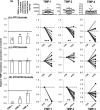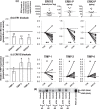Involvement of Angiotensin II Type 1 and 2 Receptors in Gelatinase Regulation in Human Carotid Atheroma in vitro
- PMID: 26947595
- PMCID: PMC7399274
- DOI: 10.5551/jat.31401
Involvement of Angiotensin II Type 1 and 2 Receptors in Gelatinase Regulation in Human Carotid Atheroma in vitro
Abstract
Aim: Matrix metalloproteinases (MMPs), angiotensin II (AII) and its receptors are implicated in atherosclerotic plaque instability, however the roles of the two receptor subtypes, ATR1 and ATR2, in MMP regulation remain uncertain. In this study, we investigated the effect of ATR1 and ATR2 blockade on the expression and activity of MMP-2, MMP-3 and MMP-9, in human carotid atheroma.
Methods: Atheroma samples (n=36) were obtained from patients undergoing carotid endarterectomy. The effects of ATR1 (irbesartan), ATR2 (PD123319) and combined ATR1 and ATR2 blockade on the expression and activity of the MMPs and the expression of tissue inhibitors of metalloproteinases (TIMPs) were investigated in explant culture experiments. Paired atheroma samples were incubated with the intervention or media control for 4 days. Protein levels (MMP-2, MMP-3, MMP-9, TIMP-1, TIMP-2, TIMP-4, ATR1 and ATR2) were determined by ELISA. Overall gelatinase activity and specific activation were measured by chromogenic activity assays and zymography, respectively.
Results: ATR1 blockade, but not ATR2 blockade significantly reduced TIMP-1, TIMP-2 and TIMP-4 expression in atheroma supernatant. Combined ATR1 and ATR2 blockade significantly reduced MMP-2, MMP-3 and MMP-9 expression. MMP-2 and MMP-9 relative activation, and overall MMP-9 catalytic capacity were significantly increased by ATR1 blockade.
Conclusions: Our findings suggest that ATR1 blockade reduces TIMP expression and increases gelatinase activity in human carotid atheroma.
Figures












Similar articles
-
Role of the angiotensin converting enzyme 1/angiotensin II/angiotensin receptor 1 axis in interstitial collagenase expression in human carotid atheroma.Atherosclerosis. 2013 Aug;229(2):331-7. doi: 10.1016/j.atherosclerosis.2013.05.022. Epub 2013 Jun 1. Atherosclerosis. 2013. PMID: 23880184
-
Angiotensin receptor 1 blockade reduces secretion of inflammation associated cytokines from cultured human carotid atheroma and vascular cells in association with reduced extracellular signal regulated kinase expression and activation.Atherosclerosis. 2014 Sep;236(1):108-15. doi: 10.1016/j.atherosclerosis.2014.06.011. Epub 2014 Jun 28. Atherosclerosis. 2014. PMID: 25016365
-
Interplay of angiotensin II and angiotensin(1-7) in the regulation of matrix metalloproteinases of human cardiocytes.Exp Physiol. 2008 May;93(5):599-612. doi: 10.1113/expphysiol.2007.041830. Epub 2008 Feb 22. Exp Physiol. 2008. PMID: 18296491
-
Gene expression levels of matrix metalloproteinases in human atherosclerotic plaques and evaluation of radiolabeled inhibitors as imaging agents for plaque vulnerability.Nucl Med Biol. 2014 Aug;41(7):562-9. doi: 10.1016/j.nucmedbio.2014.04.085. Epub 2014 Apr 21. Nucl Med Biol. 2014. PMID: 24853402
-
[Matrix metalloproteinases and their endogenous regulators in squamous cervical carcinoma (review of the own data)].Biomed Khim. 2015 Nov-Dec;61(6):694-704. doi: 10.18097/PBMC20156106694. Biomed Khim. 2015. PMID: 26716740 Review. Russian.
Cited by
-
New Concepts on the Pathophysiology of Acute Coronary Syndrome.Rev Cardiovasc Med. 2023 Apr 17;24(4):112. doi: 10.31083/j.rcm2404112. eCollection 2023 Apr. Rev Cardiovasc Med. 2023. PMID: 39076267 Free PMC article. Review.
-
Gelatinase and Vulnerability of Atherosclerotic Plaque.J Atheroscler Thromb. 2016 Jul 1;23(7):766-8. doi: 10.5551/jat.ED048. Epub 2016 May 25. J Atheroscler Thromb. 2016. PMID: 27237102 Free PMC article. No abstract available.
-
Fenofibrate in the management of AbdoMinal aortic anEurysm (FAME): study protocol for a randomised controlled trial.Trials. 2017 Jan 4;18(1):1. doi: 10.1186/s13063-016-1752-z. Trials. 2017. PMID: 28049491 Free PMC article. Clinical Trial.
References
-
- Golledge J, Greenhalgh RM, Davies AH: The symptomatic carotid plaque. Stroke, 2000; 31: 774-781 - PubMed
-
- Dollery CM, Libby P: Atherosclerosis and proteinase activation. Cardiovasc Res, 2005; 69: 625-635 - PubMed
-
- Sukhova GK, Schonbeck U, Rabkin E, Schoen FJ, Poole AR, Billinghurst RC, Libby P: Evidence for increased Collagenolysis by interstitial Collagenases-1 and -3 in Vulnerable Human Atheromatous Plaques. Circulation, 1999; 99: 2503-2509 - PubMed
-
- Shah PK: Mechanisms of plaque vulnerability and rupture. J Am Coll Cardiol, 2003; 41: 15S-22S - PubMed
-
- Pardo A, Selman M: MMP-1: the elder of the family. Int J Biochem Cell Biol, 2005; 37: 283-288 - PubMed
MeSH terms
Substances
LinkOut - more resources
Full Text Sources
Other Literature Sources
Medical
Research Materials
Miscellaneous

